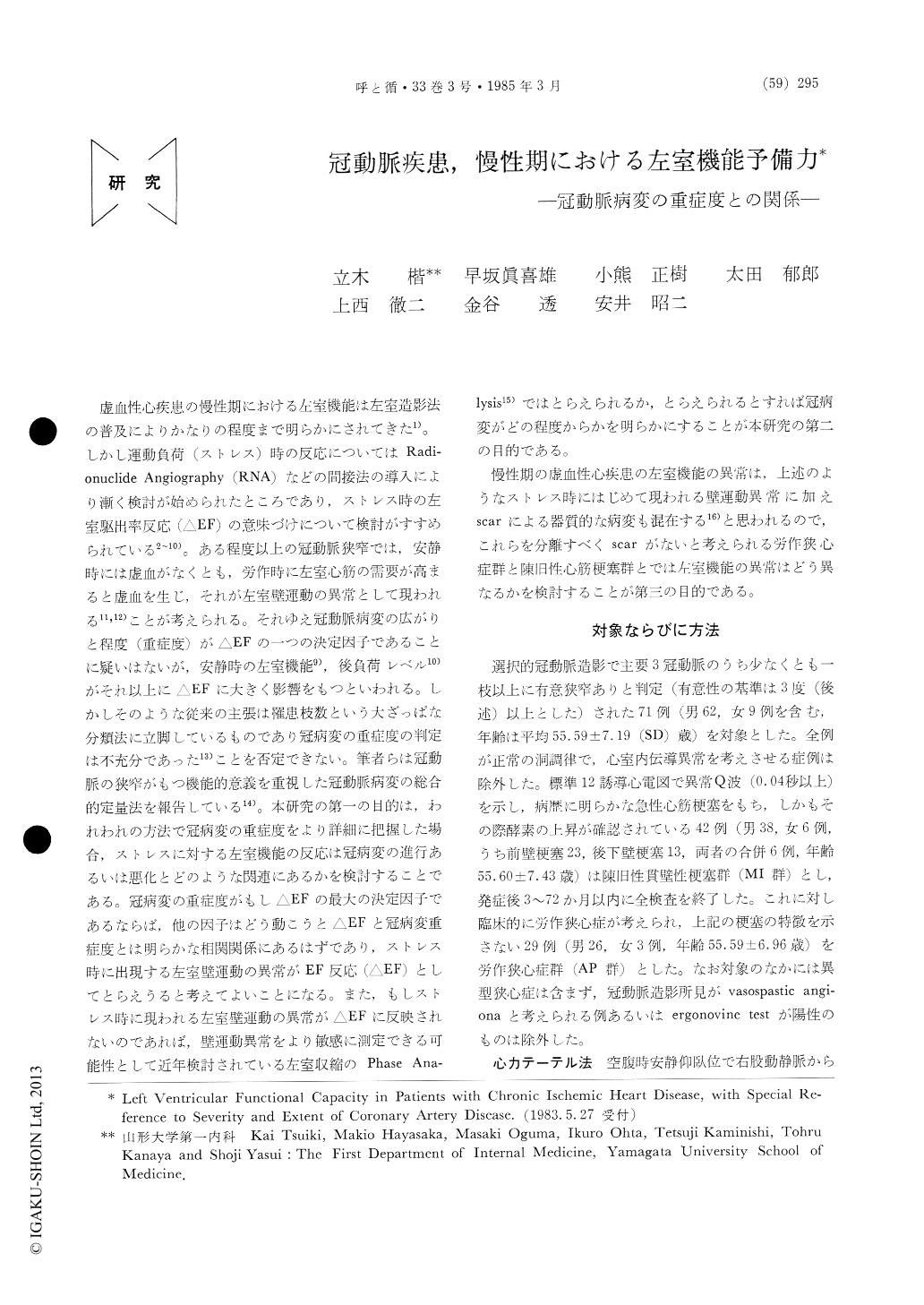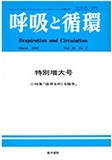Japanese
English
- 有料閲覧
- Abstract 文献概要
- 1ページ目 Look Inside
虚血性心疾患の慢性期における左室機能は左室造影法の普及によりかなりの程度まで明らかにされてきた1)。しかし運動負荷(ストレス)時の反応についてはRadi—onuclide Angiography (RNA)などの間接法の導入により漸く検討が始められたところであり,ストレス時の左室駆出率反応(△EF)の意味づけについて検討がすすめられている2〜10)。ある程度以上の冠動脈狭窄では,安静時には虚血がなくとも,労作時に左室心筋の需要が高まると虚血を生じ,それが左室壁運動の異常として現われる11,12)ことが考えられる。それゆえ冠動脈病変の広がりと程度(重症度)が△EFの一つの決定因子であることに疑いはないが,安静時の左室機能9),後負荷レベル10)がそれ以上に△EFに大きく影響をもつといわれる。しかしそのような従来の主張は罹患枝数という大ざっぱな分類法に立脚しているものであり冠病変の重症度の判定は不充分であった13)ことを否定できない。筆者らは冠動脈の狭窄がもつ機能的意義を重視した冠動脈病変の総合的定量法を報告している14)。本研究の第一の目的は,われわれの方法で冠病変の重症度をより詳細に把握した場合,ストレスに対する左室機能の反応は冠病変の進行あるいは悪化とどのような関連にあるかを検討することである。冠病変の重症度がもし△EFの最大の決定因子であるならば,他の因子はどう動こうと△EFと冠病変重症度とは明らかな相関関係にあるはずであり,ストレス時に出現する左室壁運動の異常がEF反応(△EF)としてとらえうると考えてよいことになる。また,もしストレス時に現われる左室壁運動の異常が△EFに反映されないのであれば,壁運動異常をより敏感に測定できる可能性として近年検討されている左室収縮のPhase Ana—lysis15)ではとらえられるか,とらえられるとすれば冠病変がどの程度からかを明らかにすることが本研究の第二の目的である。
慢性期の虚血性心疾患の左室機能の異常は,上述のようなストレス時にはじめて現われる壁運動異常に加えscarによる器質的な病変も混在する16)と思われるので,これらを分離すべくscarがないと考えられる労作狭心症群と陳旧性心筋梗塞群とでは左室機能の異常はどう異なるかを検討することが第三の目的である。
We studied the left ventricular ejection fraction (EF), the maximal phase delay (MPD) and thefirst-third filling fraction (IT) responses to supine exercise using first-pass radionuclide angiography in 71 patients with significant coronary artery disease, including 42 with previous transmural myocardial infarction (MI group) and 29 without MI (AP group). Severity and extent of coronary artery disease were assessed by Pujadas score (PS) system which we proposed previously and showed to be correlated well with indices for myocardial ischemia during stress.
The EF response to exercise (ΔEF) was roughly correlated with PS (r=0.31, n=52), although there was no difference in the correlation between MI (n=28) and AP (n=24) groups. The MPD response (ΔMPD) was fairly constant around O msec in cases with AP and with PS less than 9. Beyond that value of PS, there was a linear correla-tion (r=0.90, n=10) indicating that ventricular asynergy appeared and progressively increased as the coronary artery disease became more severe in AP group (n=23). With MI group (n=25), however, no such a correlation was found. The relationship between ΔEF and ΔFF was steeper in MI (ΔFF=1.33 (ΔEF)-12.9, n=15) as com-pared to AP (ΔFF =0.51 (ΔEF)-0.83, n=15).In these subgroups, there were no differences in the indices for adequacy of the stress.
These observations indicate that left ventricular wall motion abnormality (asynergy) induced on stress was evidenced on the phase response of radionuclide technique, but not on EF response in patients with AP. Scar tissue within the ventricular wall with MI may play an important role in determining ventricular mechanical property during stress.

Copyright © 1985, Igaku-Shoin Ltd. All rights reserved.


